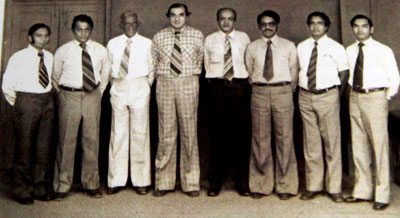New book traces history of cinnamon in Sri Lanka
A book that gives an insight into and the history of Sri Lanka’s spice industry, the trade and exports explained by a pioneer in the spice trade – Gulam S. Chatoor – recreates how the posh residential area – Cinnamon Gardens or ‘Kurundu Watte’ in Colombo came to exist from the Dutch era.
This small book titled “The Spic(e)y Story” covers the history of the spice industry with some rare pictures and ample information was launched on Monday at the HNB Towers in Colombo. The event was organized by the Spices and Allied Products Producers and Traders Association of Sri Lanka (SAPPTA).
Sri Lanka is one the largest growers of Cinnamon globally and the number one exporter to the world.
According to the book ‘Cinnamon is a native plant in Sri Lanka, grew wild until the Dutch started growing it in plantations. To test as to how the plant would grow, they started to grow in Colombo in the area now known as Cinnamon Gardens. Thus the present day posh residential area – once literally a ‘Kurundu-kelle’ which later became Kurundu-watte Cinnamon Gardens, Colombo 7 – is synonymous with the upmarket trends in the capital city.
While tracing the history of Colombo the book indicates that Pettah, once a residential area during the Dutch time, became a trading hub with diverse races – Sinhalese, Moors, Tamils, Parsees, Dutch, Portuguese, Malays and Afghans.
It traces how the word spice derived from the old French word espice which came from Latin root spec. The various spices are described in the book as to its various uses, medicinal value, food additive, used in perfumes, cosmetics, etc.
In this manner, the book analyses Turmeric, Licorice (velmee), Garlic, Fennel, Mustard, Cardamoms, Pepper, Cloves, Nutmeg, and Ginger among other spices.
It explains that Egyptian embalmers had used spices to perfume the corpses of royalty and slow down bacterial decomposition in the process of mummification.
Cinnamon had been used to scent the funeral pyres of kings and emperors and the wealthy in the Roman Empire were cremated with cinnamon.
The book indicates that although the Dutch were keen to continue spice export with cinnamon growing, the British invasion in then Ceylon in 1796 saw them capture the Kandyan Kingdom in 1815 and promote coffee plantation, instead of cinnamon. In the 1870s coffee failed, and its replacement, tea plantation proved to be a great success.
Tracing the foot-prints of the ancestral family business the book notes that in 1915 an entrepreneur from Mumbai, Saboor Chatoor came to Colombo, established ‘Chatoor and Co’ to import commodities from India. The company later expanded and moved to export business to India and Europe.
Present Chairman of the Company, Gulam S. Chatoor, in the book says World War II disrupted the business and some of their family members moved to Mumbai.
And there he learnt about ‘pepper’ and he writes, “Little did I know that in time to come, in the early 1950s I was to become one of the largest exporters of pepper from Sri Lanka”.
The company name was changed to Saboor Chatoor & Co Ltd. He joined the business in 1948 and with the war ending in 1945 their company became the largest export of various types of agricultural products, mainly spices.
In early days the exchange rates were low, pepper and cloves were sold at around one rupee per pound and the workers were paid Rs. 2.50 per day compared to Rs. 650 per day now. Today pepper would fetch Rs. 1,300 per kg and cloves Rs. 1,200 per kg and the standards called for by the consumer is rather stringent, the book indicates.
At the end, Mr. Chatoor notes in the book: “When I look back I am amazed to see the change in prices and foreign currency values during the past six or seven decades. After another few decades these prices would be still much higher.”

(1) Cover of the book, (2) Gulam S. Chatoor (4th from left) with members of a spice delegation he led to India in 1980.


